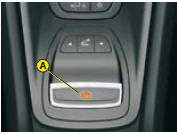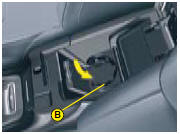Electric parking brake

The electronic parking brake combines 2 operational modes:
AUTOMATIC:
Automatic application when the engine is stopped and automatic release on use of the accelerator (automatic operation by default).
MANUAL:
The MANUAL application/release of the parking brake is possible permanently by pulling/pushing control A.
Automatic operation
To start the vehicle
The parking brake releases automatically and progressively when you press the accelerator:
With a manual gearbox (first gear or reverse gear engaged), press down fully on the clutch pedal then press on the accelerator pedal and move off.
With an automatic gearbox, accelerate with the selector in position D, M or R.

 Full release of the parking brake is
confirmed by:
Full release of the parking brake is
confirmed by:
The extinction of the warning lamp on control A and of the instrument panel warning lamp.
The display of the message “Parking brake released” on the instrument panel screen.
When stationary, with the engine running, do not press the accelerator pedal unnecessarily (especially when starting the engine, including when in neutral), as you may release the parking brake.
To immobilise the vehicle
Immobilisation, engine off With the vehicle stationary, the parking brake is automatically applied when the engine is switched off.

 The application of the parking brake
is confirmed by:
The application of the parking brake
is confirmed by:
The lighting of the warning lamp on control A and of the warning lamp on the instrument panel.
The display of the message “Parking brake applied” on the instrument panel screen.
Note: an operation sound will confirm to you the application/release of your electronic parking brake.
Before leaving the vehicle, check that the parking brake warning lamp on the
instrument panel is permanently lit.
Never leave a child alone inside the vehicle with the ignition on, as they could
release the parking brake.

Immobilisation, engine running
With the engine running and the vehicle stationary, in order to immobilise the vehicle you need to manually apply the parking brake by pulling on control A.

 The application of the parking brake
is confirmed by:
The application of the parking brake
is confirmed by:
The lighting of the warning lamp on control A and of the warning lamp on the instrument panel.
The display of the message “Parking brake applied” on the instrument panel screen.
When the driver’s door is opened, a beep is heard and a message displayed if the parking brake has not been applied.
Before leaving the vehicle, check that the parking brake warning lamp on the instrument panel is permanently lit.
ACTIVATION / DEACTIVATION OF THE AUTOMATIC FUNCTIONS
The automatic application when the engine is switched off and the automatic release when you press the accelerator can be deactivated.
Activation / deactivation is performed using the “Main Menu” of the instrument panel screen.
To do so, select “Vehicle parameters / Comfort / Automatic parking brake”.
 The deactivation of these functions
is confirmed by the lighting of this warning lamp on the instrument panel.
The deactivation of these functions
is confirmed by the lighting of this warning lamp on the instrument panel.
With the automatic functions deactivated, the application and release of the parking brake are done manually.
The deactivation of the automatic functions is recommended in particularly cold conditions (ice) and during towing (breakdown, caravan, etc).
Manual operation
Manual application / release of the parking brake is always possible.
To start the vehicle
With the ignition on or the engine running, to release the parking brake, press on the brake or accelerator pedal, push then release control A.

 Full release of the parking brake is
confirmed by:
Full release of the parking brake is
confirmed by:
The extinction of the warning lamp on control A and of the instrument panel warning lamp.
The display of the message “Parking brake released” on the instrument panel screen.
Remark: If you push control A without pressing the brake pedal, the parking brake will not be released and the message “Foot on brake necessary” will be displayed on the instrument panel screen.
To immobilise the vehicle
With the vehicle stationary, to apply the parking brake whether the engine is running or off, pull on control A.

 The application of the parking brake
is confirmed by:
The application of the parking brake
is confirmed by:
The lighting of the warning lamp on control A and of the warning lamp on the instrument panel.
The display of the message “Parking brake applied” on the instrument panel screen.
When the driver’s door is opened with the engine running, a beep is heard and a message displayed if the parking brake has not been applied.
Maximum application
If necessary, you can utilise maximum application of the parking brake. It is obtained by means of a long pull on control A, until you see the message “Maximum parking brake application” and a beep is heard.
Maximum application is indispensable:
In the case of a vehicle towing a caravan or a trailer, if the automatic functions are activated but you are applying the parking brake manually.
When the gradient you are parked on is variable in its effect (e.g. on a ferry, in a lorry, during towing).
Note: In the case of towing, a loaded vehicle or parking on a gradient, turn the front wheels towards the pavement and engage a gear when you park.
After maximum application, the release time will be longer.
Particular situations
In certain situations (starting the engine, etc), the parking brake can automatically alter its force. This is normal operation.
To advance your vehicle a few centimetres without starting the engine, but with the ignition on, press on the brake pedal and release the parking brake by pushing then releasing control A.
The full release of the parking brake is confirmed by the extinction of the warning lamp on control A, and of the warning lamp on the instrument panel, and by the display of the message “Parking brake released” on the instrument panel screen.
If the parking brake malfunctions while applied or if the battery runs flat, an emergency release is always possible (see paragraph “Emergency unlocking”).
In order to guarantee its correct operation and therefore your safety, the
number of consecutive applications/releases of your parking brake is limited to
eight times.
In case of misues, you are alerted by the message “Parking brake faulty” and the
warning lamp ! which flashes (see chapter “Operating anomalies”).

Dynamic emergency braking
In the event of a failure of the vehicle’s main braking system or in an exceptional situation (e.g. driver taken ill, under instruction, etc) a continuous pull on control A will stop the vehicle.
The electronic stability programme (ESP) provides stability during dynamic emergency braking.
If the dynamic emergency braking malfunctions, one of the following messages will be displayed on the instrument panel screen:
“Parking brake faulty”.
“Parking brake control faulty”.
 If a failure of the ESP system is
signalled by the lighting of this warning lamp, then braking stability is not guaranteed.
In this event, stability must be assured by the driver by repeating alternate “pullrelease”
actions on control A.
If a failure of the ESP system is
signalled by the lighting of this warning lamp, then braking stability is not guaranteed.
In this event, stability must be assured by the driver by repeating alternate “pullrelease”
actions on control A.
The dynamic emergency braking must only be used in exceptional circumstances.

Unlocking in emergency
In the event of the electric parking brake malfunctioning or the battery running flat, an emergency manual device can be used to unlock it.
1 Immobilise the vehicle, with the engine running, by engaging first gear (manual gearbox) or position P (automatic gearbox), then switch off the ignition and remove the key.
Note: If it is impossible to immobilise the vehicle, do not action the unlocking control and urgently contact a CITROËN dealer.

2. Fetch the vehicle block located in the boot.
3. Immobilise the vehicle by placing the block in front of or behind one of the
rear wheels.
4. Open the lower compartment of the central armrest by pulling upwards.
5. Ensure that the cup-holder B is folded back.
6. Remove the rubber mat covering the base of the armrest.
7. Disengage the strap from its location C.
8. Pull the strap to unlock the brake. A loud click confirms that the brake is
unlocked.

9. Make sure that you position the strap back in its location C. If not, the application of the parking brake will not be possible.
Contact a CITROËN dealer.
10. Refit the rubber mat at the base of the armrest.
11. Remove and store the block.

Note: It is necessary to check that the parking brake warning lamp lights up on the instrument panel when the parking brake is applied.
Remark: Diagnostic socket in the armrest strengthener. Ensure that you do not allow any dusty or damp elements near the diagnostic socket D which is essential for the maintenance of your vehicle.
This strap cannot apply the parking brake.
To re-engage the electric parking brake (once the malfunction or the flat battery
has been resolved), make a long pull on the control lever A until the parking brake
warning lamp (!) flashes on the instrument panel then make a second long pull until
this warning lamp remains lit permanently.
The time for applying the brake subsequent to the emergency unlocking will be longer.
While the parking brake has not been re-engaged (flashing then permanent lighting
of warning lamp (!) on the instrument panel), you must keep the ignition switched
off to avoid damaging it.
Operating anomalies


If any of these instances arises, contact a CITROËN dealer as soon as possible.
See also:
Checks / Oil level
Log of alerts
This function allows you to display the log of alerts.
Press on button A. The following messages appear consecutively on the instrument
panel screen:
Tyre pressure check.
Mainten ...
Getting started
Front seats
Manual adjustments
A. Adjustment of the backrest angle.
B. Adjustment of the seat height and angle.
C. Heated seat control.
D. Longitudinal adjustment of seat.
E. Adjustment of the ...
Changing a fuse
Before changing a fuse, the cause of the
failure must be identifi ed and rectifi ed.
Identify the faulty fuse by checking
the condition of its fi lament.
Correct
Incorrect
Use the special ...






